Evaluation of the extent of movement of the shoulder after breast cancer treatment.
DOI:
https://doi.org/10.20344/amp.1716Abstract
Treatment of breast cancer generally involves quadrantectomy and mastectomy followed by radiotherapy and chemotherapy depending on indication. The object of the present study was to verify the extent of movement of the shoulder after breast cancer treatment and the influence of the type of surgery (quadrantectomy and mastectomy). A total of 90 women submitted to surgery for breast cancer in the Region of Catanduva, Brazil and a control group of 20 women without surgical compromise were evaluated. The extents of bilateral flexion and abduction movements of the shoulders were assessed by goniometry. The non-matched student t-test and Fisher exact test were utilized for statistical analysis with an alpha error of up to 5% being considered acceptable. Differences of 20 degrees or more in the extent of movement of the shoulders of women submitted to surgery were seen in 47.7% of the cases for flexion and in 56.6% for abduction. The compromise to the movement of the shoulder in the control group was less than 20 degrees in 9 (45%) of the women. On comparing the incidence of alterations in the movements of the arms of women submitted to surgery with the control group, a significant difference was identified for both limbs (p-value < 0.01). The articular mobility of both arms of patients submitted to treatment for breast cancer can be affected.Downloads
Downloads
How to Cite
Issue
Section
License
All the articles published in the AMP are open access and comply with the requirements of funding agencies or academic institutions. The AMP is governed by the terms of the Creative Commons ‘Attribution – Non-Commercial Use - (CC-BY-NC)’ license, regarding the use by third parties.
It is the author’s responsibility to obtain approval for the reproduction of figures, tables, etc. from other publications.
Upon acceptance of an article for publication, the authors will be asked to complete the ICMJE “Copyright Liability and Copyright Sharing Statement “(http://www.actamedicaportuguesa.com/info/AMP-NormasPublicacao.pdf) and the “Declaration of Potential Conflicts of Interest” (http:// www.icmje.org/conflicts-of-interest). An e-mail will be sent to the corresponding author to acknowledge receipt of the manuscript.
After publication, the authors are authorised to make their articles available in repositories of their institutions of origin, as long as they always mention where they were published and according to the Creative Commons license.









